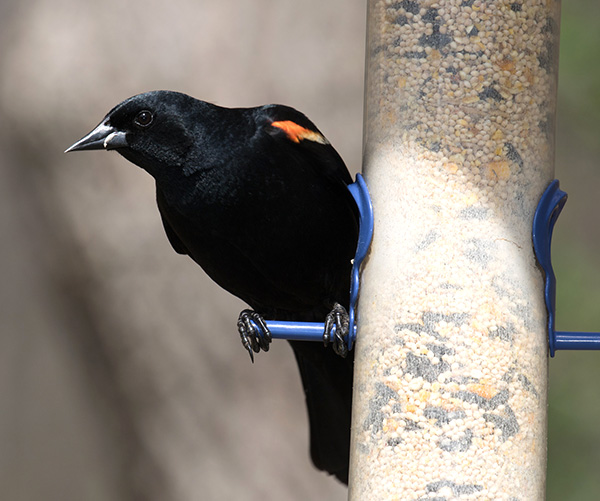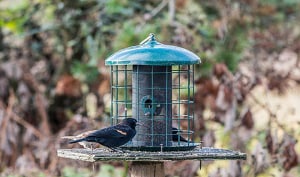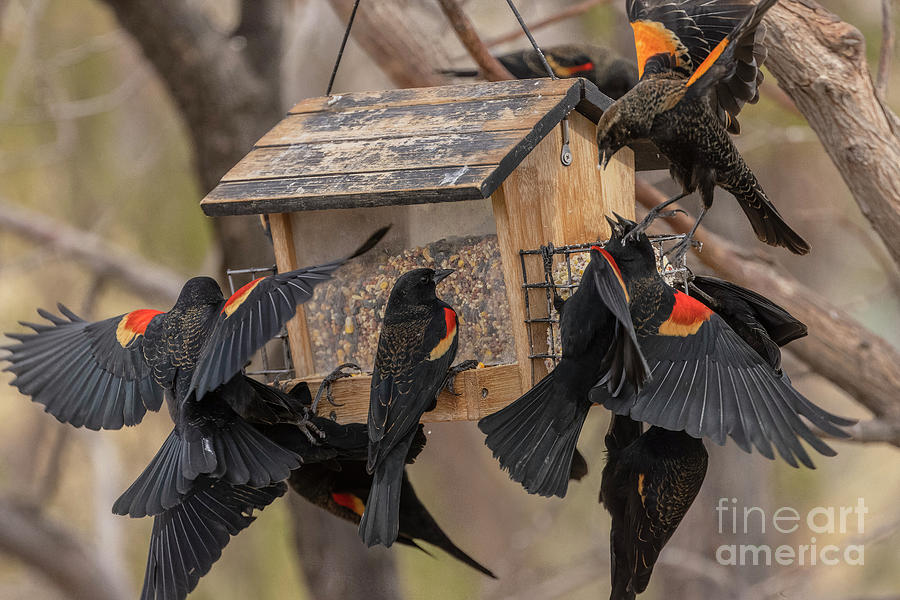Understanding the Attraction: Why Blackbirds Flock to Feeders
Blackbirds are attracted to bird feeders for a variety of reasons, primarily due to the abundance of food and water. These birds are omnivores, which means they eat both plants and animals, and they are particularly fond of seeds, fruits, and insects. Bird feeders often provide a convenient and reliable source of these food sources, making them an ideal destination for blackbirds.
One of the main reasons blackbirds are drawn to feeders is the ease of access to food. Feeders typically have large openings or trays that allow birds to easily land and feed, making it simple for blackbirds to get the food they need. Additionally, many feeders are designed with perches or ledges that allow birds to comfortably feed, which can make it even more appealing to blackbirds.
Another factor that contributes to the attraction of blackbirds to feeders is the presence of water. Many bird feeders are placed near birdbaths or other water sources, which can make the area even more appealing to blackbirds. These birds need water for drinking and bathing, and the presence of a reliable water source can make a feeder even more attractive.
Understanding why blackbirds are attracted to feeders is the first step in learning how to keep them off. By recognizing the factors that draw these birds to feeders, you can begin to develop strategies for deterring them. In the next section, we will explore the features of bird feeders that can help deter blackbirds and keep them away from your yard.
Choosing the Right Feeder: Blackbird-Deterrent Designs
When it comes to keeping blackbirds off your feeders, the type of feeder you use can make a big difference. Some bird feeders are designed with features that can help deter blackbirds, making it easier to keep them away. One such feature is weight-activated perches. These perches are designed to collapse or shut off access to the feeder when a bird of a certain weight lands on them, making it difficult for blackbirds to feed.
Another type of feeder that can help keep blackbirds away is cage-like enclosures. These feeders have a mesh or wire enclosure that surrounds the feeding area, allowing smaller birds to enter while keeping larger birds like blackbirds out. The enclosure can be adjusted to allow different sizes of birds to enter, making it a versatile option for bird enthusiasts.
Feeders with small openings are also effective at keeping blackbirds away. These feeders have openings that are just large enough for small birds to enter, making it difficult for blackbirds to access the food inside. This type of feeder is particularly effective when used in conjunction with other deterrents, such as visual or auditory repellents.
When choosing a bird feeder, consider the types of birds you want to attract and the types you want to deter. By selecting a feeder with blackbird-deterrent features, you can help keep these birds away and create a more enjoyable bird-watching experience. In the next section, we will explore the importance of positioning your feeder strategically to minimize blackbird visits.
Positioning for Success: Strategic Placement of Feeders
When it comes to keeping blackbirds off your feeders, the placement of the feeder can play a significant role. By positioning your feeder in a strategic location, you can minimize the likelihood of blackbirds visiting your yard. One effective way to do this is to place your feeder near shrubs or trees. This will provide smaller birds with a safe haven to feed, while making it more difficult for blackbirds to access the feeder.
Another tip is to avoid placing your feeder in areas with dense vegetation. Blackbirds tend to prefer areas with dense cover, as it provides them with protection from predators. By placing your feeder in an open area, you can make it less appealing to blackbirds. Additionally, consider placing your feeder at least 10 feet away from any structures, such as buildings or fences, to prevent blackbirds from using them as a launching point to access the feeder.
It’s also important to consider the direction of the sun when placing your feeder. Blackbirds tend to prefer feeding in areas that receive direct sunlight, so placing your feeder in a shaded area can make it less appealing to them. By positioning your feeder in a strategic location, you can make it more difficult for blackbirds to access the feeder and reduce the likelihood of them visiting your yard.
Remember, the key to keeping blackbirds off your feeders is to make it difficult for them to access the food. By combining strategic placement with other deterrents, such as blackbird-resistant seed types and visual repellents, you can create a blackbird-free zone in your yard. In the next section, we will explore the types of birdseed that are less attractive to blackbirds and how to use them to your advantage.
Food for Thought: Blackbird-Resistant Seed Types
When it comes to keeping blackbirds off your feeders, the type of seed you use can play a significant role. Blackbirds tend to prefer seeds that are high in fat and protein, such as sunflower seeds and mixed seed blends. However, there are several types of seed that are less attractive to blackbirds, making them a great option for bird enthusiasts who want to keep these birds away.
One such seed type is safflower seeds. These seeds are a good alternative to sunflower seeds, as they are less preferred by blackbirds. Safflower seeds are also a good source of nutrition for smaller birds, such as finches and sparrows. Another option is nyjer seeds, which are high in oil and calories, making them a favorite among smaller birds. Nyjer seeds are also less likely to attract blackbirds, as they are not as easily accessible to these larger birds.
Hot pepper-infused seeds are another option for keeping blackbirds away. These seeds are coated with a spicy substance that is unappealing to blackbirds, but not to smaller birds. This makes them a great option for bird enthusiasts who want to attract a variety of bird species to their yard, while keeping blackbirds away.
By using blackbird-resistant seed types, you can make your feeder less appealing to these birds and reduce the likelihood of them visiting your yard. Remember to combine this strategy with other deterrents, such as strategic feeder placement and visual repellents, to create a blackbird-free zone in your yard. In the next section, we will explore the use of visual and auditory repellents to scare blackbirds away.
Additional Deterrents: Visual and Auditory Repellents
In addition to using blackbird-resistant seed types and strategic feeder placement, there are several visual and auditory repellents that can be used to scare blackbirds away. One such repellent is shiny reflective surfaces. Blackbirds are naturally wary of shiny objects, and placing reflective surfaces near your feeder can help to deter them. You can use aluminum foil, CDs, or other shiny materials to create a reflective surface.
Predator decoys are another effective visual repellent. Blackbirds have a natural fear of predators, and placing a decoy near your feeder can help to scare them away. You can use a fake owl, hawk, or other predator decoy to create the illusion of a threat. Just be sure to move the decoy regularly to avoid habituation.
Ultrasonic bird repellers are also a popular option for keeping blackbirds away. These devices emit a high-frequency sound that is undetectable to humans but unpleasant for birds. By placing an ultrasonic bird repeller near your feeder, you can help to deter blackbirds and other unwanted bird species.
Other visual and auditory repellents that can be used to keep blackbirds away include balloons, wind chimes, and bird-scaring tape. These repellents can be used alone or in combination with other methods to create a comprehensive blackbird-deterrent system. By using a combination of these methods, you can effectively keep blackbirds off your feeders and enjoy a more peaceful bird-watching experience.
Netting and Screening: Physical Barriers to Blackbirds
One of the most effective ways to keep blackbirds off your feeders is to use physical barriers, such as netting or screening. By covering your feeder with a physical barrier, you can prevent blackbirds from accessing the food inside. Netting or screening can be placed over the feeder, or it can be used to create a cage-like enclosure around the feeder.
When choosing a netting or screening material, it’s essential to select a material that is durable and long-lasting. Blackbirds can be persistent, and they may try to chew through or peck at the netting or screening to get to the food. Look for materials that are specifically designed for bird control, such as polypropylene or nylon netting.
Another benefit of using netting or screening is that it can also help to keep other unwanted birds away from your feeder. By creating a physical barrier, you can prevent birds like sparrows, finches, and starlings from accessing the food, which can help to reduce competition for the birds you want to attract.
When installing netting or screening, make sure to follow the manufacturer’s instructions and take necessary precautions to ensure that the material is securely attached to the feeder. You may also want to consider using a combination of netting or screening with other deterrents, such as visual or auditory repellents, to create a comprehensive blackbird-deterrent system.
Maintenance Matters: Keeping Feeders Clean and Free of Debris
Regular maintenance is crucial to keeping blackbirds off your feeders. One of the most important things you can do is to keep your feeders clean and free of debris. Blackbirds are attracted to feeders that are dirty or have a buildup of debris, as this can provide them with a source of food. By regularly cleaning your feeders, you can help to prevent the buildup of debris and mold, which can attract blackbirds.
It’s recommended to clean your feeders at least once a week, or more often if you notice a buildup of debris. Use a mild detergent and warm water to clean the feeder, and make sure to rinse it thoroughly to remove any soap residue. You should also clean the area around the feeder, including any nearby plants or trees, to prevent the spread of debris and mold.
In addition to regular cleaning, it’s also important to check your feeders regularly for signs of wear and tear. If you notice any damage or deterioration, make sure to repair or replace the feeder as soon as possible. This will help to prevent blackbirds from taking advantage of any weaknesses in the feeder and will also help to keep your feeders in good condition.
By keeping your feeders clean and well-maintained, you can help to prevent blackbirds from visiting your yard and reduce the risk of them becoming a nuisance. Remember to combine regular maintenance with other deterrents, such as using blackbird-resistant seed types and visual repellents, to create a comprehensive blackbird-deterrent system.
Conclusion: A Blackbird-Free Feeder is a Happy Feeder
By following the tips and strategies outlined in this article, you can effectively keep blackbirds off your feeders and create a more enjoyable bird-watching experience. Remember, the key to success is to use a combination of methods, such as choosing the right feeder, positioning it strategically, using blackbird-resistant seed types, and incorporating visual and auditory repellents.
Regular maintenance is also crucial to keeping blackbirds away, so make sure to clean and maintain your feeders regularly. By taking these steps, you can help to prevent blackbirds from becoming a nuisance and enjoy the beauty of nature in your own backyard.
So, don’t let blackbirds take over your bird feeders Try a combination of these methods and see what works best for you. With a little creativity and persistence, you can keep blackbirds off your feeders and enjoy a blackbird-free bird-watching experience.
By following these simple tips, you can create a bird-friendly environment that is free from the nuisance of blackbirds. So, go ahead and give it a try Your bird feeders – and the birds that visit them – will thank you.






